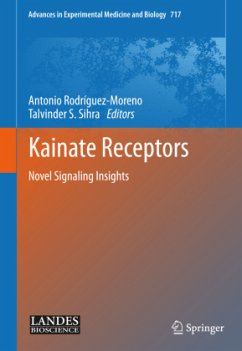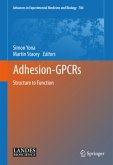Kainate Receptors
Novel Signaling Insights
Herausgegeben:Rodriguez-Moreno, Antonio; Sihra, Talvinder S.
Kainate Receptors
Novel Signaling Insights
Herausgegeben:Rodriguez-Moreno, Antonio; Sihra, Talvinder S.
- Gebundenes Buch
- Merkliste
- Auf die Merkliste
- Bewerten Bewerten
- Teilen
- Produkt teilen
- Produkterinnerung
- Produkterinnerung
This volume critically examines the functional actions of the kainate?type glutamate receptors (KARs). Following on from the larger body of work on the NMDA? and AMPA-type ionotropic glutamate receptors (GluRs), studies with KARs have consistently thrown up exceptions to general rules about synaptic modulation. Contributors herein provide an insight to the idiosyncracies that now almost typify the KAR field. The fascinating insights provided in this volume serve to encourage searching mechanistic questions.
Andere Kunden interessierten sich auch für
![Adhesion-Gpcrs Adhesion-Gpcrs]() Adhesion-Gpcrs112,99 €
Adhesion-Gpcrs112,99 €![Molecular Diagnostics: Promises and Possibilities Molecular Diagnostics: Promises and Possibilities]() Mousumi DebnathMolecular Diagnostics: Promises and Possibilities134,99 €
Mousumi DebnathMolecular Diagnostics: Promises and Possibilities134,99 €![Mast Cell Biology Mast Cell Biology]() Mast Cell Biology149,99 €
Mast Cell Biology149,99 €![The Arterial Chemoreceptors The Arterial Chemoreceptors]() Yoshiaki Hayashida / Constancio Gonzalez / Hisatake Kondo (eds.)The Arterial Chemoreceptors328,99 €
Yoshiaki Hayashida / Constancio Gonzalez / Hisatake Kondo (eds.)The Arterial Chemoreceptors328,99 €![Cell Fusion in Health and Disease Cell Fusion in Health and Disease]() Cell Fusion in Health and Disease149,99 €
Cell Fusion in Health and Disease149,99 €![Smad Signal Transduction Smad Signal Transduction]() Peter ten Dijke / Carl-Henrik Heldin (eds.)Smad Signal Transduction220,99 €
Peter ten Dijke / Carl-Henrik Heldin (eds.)Smad Signal Transduction220,99 €![Cell Signaling Reactions Cell Signaling Reactions]() Cell Signaling Reactions149,99 €
Cell Signaling Reactions149,99 €-
-
-
This volume critically examines the functional actions of the kainate?type glutamate receptors (KARs). Following on from the larger body of work on the NMDA? and AMPA-type ionotropic glutamate receptors (GluRs), studies with KARs have consistently thrown up exceptions to general rules about synaptic modulation. Contributors herein provide an insight to the idiosyncracies that now almost typify the KAR field. The fascinating insights provided in this volume serve to encourage searching mechanistic questions.
Produktdetails
- Produktdetails
- Advances in Experimental Medicine and Biology 717
- Verlag: Landes Bioscience / Springer / Springer US / Springer, Berlin
- Artikelnr. des Verlages: 80036041, 978-1-4419-9556-8
- 2011 edition
- Seitenzahl: 131
- Erscheinungstermin: 25. April 2011
- Englisch
- Abmessung: 266mm x 187mm x 17mm
- Gewicht: 388g
- ISBN-13: 9781441995568
- ISBN-10: 1441995560
- Artikelnr.: 32768907
- Herstellerkennzeichnung
- Libri GmbH
- Europaallee 1
- 36244 Bad Hersfeld
- gpsr@libri.de
- Advances in Experimental Medicine and Biology 717
- Verlag: Landes Bioscience / Springer / Springer US / Springer, Berlin
- Artikelnr. des Verlages: 80036041, 978-1-4419-9556-8
- 2011 edition
- Seitenzahl: 131
- Erscheinungstermin: 25. April 2011
- Englisch
- Abmessung: 266mm x 187mm x 17mm
- Gewicht: 388g
- ISBN-13: 9781441995568
- ISBN-10: 1441995560
- Artikelnr.: 32768907
- Herstellerkennzeichnung
- Libri GmbH
- Europaallee 1
- 36244 Bad Hersfeld
- gpsr@libri.de
ANTO NIO RODRIGUEZ¿MORENO is Associate Professor and Head of the Cellular Neuroscience and Plasticity Laboratory at the University Pablo de Olavide, in Seville, Spain. His main research interests include the study of the mechanisms of synaptic plasticity in cortex and hippocampus and the physiology of glutamate receptors of the NMDA and kainate type. He is a member of the Federation of European Neuroscience Societies (FENS) and the Society for Neuroscience (SFN). Following a degree in Biological Sciences at the University of Seville, Dr. Rodriguez¿Moreno received his PhD degree in Neurobiology and Molecular Biology from Cajal Institute and the University Automous of Madrid in Madrid, Spain. During a first postdoc at the University Pablo de Olavide, in Seville (Spain) he studied the mechanisms of learning and memory in awake animals. This was followed by a postdoctoral stay at University College London (UK) where he investigated the actions of kainate receptors using synaptosomes and brain slices. During a third postdoc at University of Oxford, he started to study the mechanisms of brain plasticity processes. TAL VINDER S. SIHRA is a Reader in Cellular and Molecular Neuroscience, and Teaching Lead in the Department of Neuroscience, Physiology and Pharmacology at University College London (UCL) UK. His main research interests are in the elucidation and characterisation of presynaptic receptors and downstream signaling pathways involved in the modulation of neurotransmitter release. Pursuant to an undergraduate degree in Biochemistry and Physiology from the University of Sheffield, UK, he completed his PhD (Biochemistry) in 1985 at the University of Dundee, Scotland, where he initiated his studies looking at the mechanisms underlying amino acid neurotransmitter release. He extended these studies at the Rockefeller University,New York, USA, in the laboratory of Professor Paul Greengard, Nobel Laureate in Medicine (2000), looking at the role of protein phosphorylation in presynaptic function and plasticity. In 1993, he obtained a faculty position at the University of London (Royal Free Hospital School of Medicine), and continued thereafter at UCL. Dr. Sihra is a member of the Biochemical Society (UK) and currently on the Signalling theme panel for the Society. He is a member of the Society of Neuroscience and former editor of the British Journal of Pharmacology. TAL VINDER S. SIHRA is a Reader in Cellular and Molecular Neuroscience, and Teaching Lead in the Department of Neuroscience, Physiology and Pharmacology at University College London (UCL) UK. His main research interests are in the elucidation and characterisation of presynaptic receptors and downstream signaling pathways involved in the modulation of neurotransmitter release. Pursuant to an undergraduate degree in Biochemistry and Physiology from the University of Sheffield, UK, he completed his PhD (Biochemistry) in 1985 at the University of Dundee, Scotland, where he initiated his studies looking at the mechanisms underlying amino acid neurotransmitter release. He extended these studies at the Rockefeller University, New York, USA, in the laboratory of Professor Paul Greengard, Nobel Laureate in Medicine (2000), looking at the role of protein phosphorylation in presynaptic function and plasticity. In 1993, he obtained a faculty position at the University of London (Royal Free Hospital School of Medicine), and continued thereafter at UCL. Dr. Sihra is a member of the Biochemical Society (UK) and currently on the Signalling theme panel for the Society. He is a member of the Society of Neuroscience and former editor of the British Journal of Pharmacology. TAL VINDER S. SIHRA is a Reader in Cellular and Molecular Neuroscience, and Teaching Lead in the Department ofNeuroscience, Physiology and Pharmacology at University College London (UCL) UK. His main research interests are in the elucidation and characterisation of presynaptic receptors and downstream signaling pathways involved in the modulation of neurotransmitter release. Pursuant to an undergraduate degree in Biochemistry and Physiology from the University of Sheffield, UK, he completed his PhD (Biochemistry) in 1985 at the University of Dundee, Scotland, where he initiated his studies looking at the mechanisms underlying amino acid neurotransmitter release. He extended these studies at the Rockefeller University, New York, USA, in the laboratory of Professor Paul Greengard, Nobel Laureate in Medicine (2000), looking at the role of protein phosphorylation in presynaptic function and plasticity. In 1993, he obtained a faculty position at the University of London (Royal Free Hospital School of Medicine), and continued thereafter at UCL. Dr. Sihra is a member of the Biochemical Society (UK) and currently on the Signalling theme panel for the Society. He is a member of the Society of Neuroscience and former editor of the British Journal of Pharmacology.
Metabotropic Actions of Kainate Receptors in the Control of GABA Release.- In the Developing Hippocampus Kainate Receptors Control the Release of GABA from Mossy Fiber Terminals via a Metabotropic Type of Action.- Localization and Functions of Kainate Receptors in the Basal Ganglia.- Metabotropic Actions of Kainate Receptors in the Control of Glutamate Release in the Hippocampus.- Metabotropic Actions of Kainate Receptors in the Regulation of IsAHP and Excitability in CA1 Pyramidal Cells.- Kainate Receptors with a Metabotropic Signature Enhance Hippocampal Excitability by Regulating the Slow After Hyperpolarization in CA3 Pyramidal Neurons.- Metabotropic Actions of Kainate Receptors in Dorsal Root Ganglion Cells.- Role of Kainate Receptors in Network Activity during Development.- Kainate Receptor Modulation by Sodium and Chloride.- BTB Kelch Proteins and Ubiquitination of Kainate Receptors
Metabotropic Actions of Kainate Receptors in the Control of GABA Release.- In the Developing Hippocampus Kainate Receptors Control the Release of GABA from Mossy Fiber Terminals via a Metabotropic Type of Action.- Localization and Functions of Kainate Receptors in the Basal Ganglia.- Metabotropic Actions of Kainate Receptors in the Control of Glutamate Release in the Hippocampus.- Metabotropic Actions of Kainate Receptors in the Regulation of IsAHP and Excitability in CA1 Pyramidal Cells.- Kainate Receptors with a Metabotropic Signature Enhance Hippocampal Excitability by Regulating the Slow After Hyperpolarization in CA3 Pyramidal Neurons.- Metabotropic Actions of Kainate Receptors in Dorsal Root Ganglion Cells.- Role of Kainate Receptors in Network Activity during Development.- Kainate Receptor Modulation by Sodium and Chloride.- BTB Kelch Proteins and Ubiquitination of Kainate Receptors








